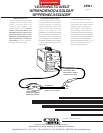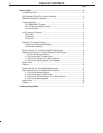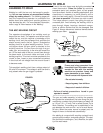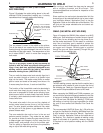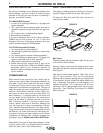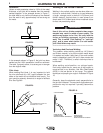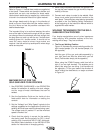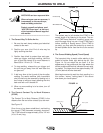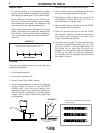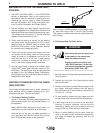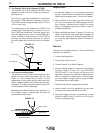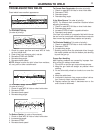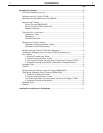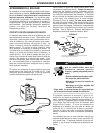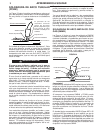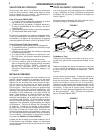
2
LEARNING TO WELD
2
LEARNING TO WELD
Welding is a skill that can only be learned by practic-
ing. No one can become an accomplished welder
simply by reading about it. The following pages will
help the inexperienced operator to understand the
basics about wire welding and provide guidance to
help develop this skill. For more detailed information,
order a copy of “New Lessons in Arc Welding”.
THE ARC-WELDING CIRCUIT
The operators knowledge of arc welding must go
beyond the arc itself. The operator must know how to
control the arc, and this requires a knowledge of the
welding circuit and the equipment that provides the
electric current used in the arc. Figure 1 illustrates the
welding circuit for a typical welding machine. The cir-
cuit begins where the gun cable is attached to the
welding machine. Current flows through the gun
cable, gun, and contact tip, to the wire and across the
arc. On the work side of the arc, current flows through
the base metal to the work cable and back to the
welding machine. This circuit must be complete for the
current to flow. Loose or poor connections anywhere
in the circuit will rob voltage from the arc and cause it
to become erratic.
This machine’s welding circuit has a voltage output of
32 volts DC maximum. This voltage is quite low and is
only present when the gun trigger is pressed.
FIGURE 1
To weld, the work clamp must be tightly connected to
clean base metal. Clean the joints by removing
excessive scale, rust, moisture, paint, oil and grease
from the surface. As with all welding applications, joint
cleanliness is necessary to avoid porosity and to
attain the best weld quality. Connect the work clamp
“as close as possible” to the area you wish to weld.
This helps prevent current from going through an
unwanted path. Avoid allowing the welding circuit to
pass through hinges, bearings, electronic compo-
nents, or similar devices that can be damaged. See
Figure 2. Always disconnect electrical devices before
welding upon them.
FIGURE 2
Fumes and slag generated from
Innershield type electrodes recom-
mended for use with this welding
machine can produce fumes and
gases hazardous to your health.
• Avoid contact with eyes and skin.
• Do not take internally.
• Keep slag away from children.
• Keep out of reach of children.
• Follow all safety precautions found in your
operator’s manual.
-----------------------------------------------------------------------
The gun and cable assembly is held by the operator
who guides the automatically fed wire along the joint,
maintaining a contact tip to work distance of about 3/8
to 1/2 inch (10 – 12 mm) This is called Contact Tip to
Work Distance. The welding arc is established in the
gap between the work and the end of a small diame-
ter wire. When the power source is properly set, the
length of the arc is maintained automatically.
Arc welding is a manual skill requiring a steady hand,
good physical condition, and good eyesight. The oper-
ator controls the welding arc, and, therefore, the quali-
ty of the weld made.
WRONG
WRONG
CURRENT
CURRENT
PATH
TH
Bearings
Hinges
Electrical Components
CORRECT
CORRECT
CURRENT
CURRENT
PATH
TH
*
* For best results position work clamp approximantely
12 inches(294mm) from the welded area.
WARNING
WORKPIECE
ARC
GUN and CABLE
WORK CLAMP



